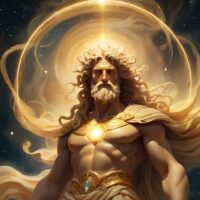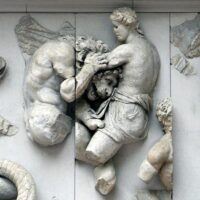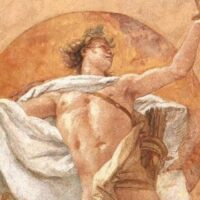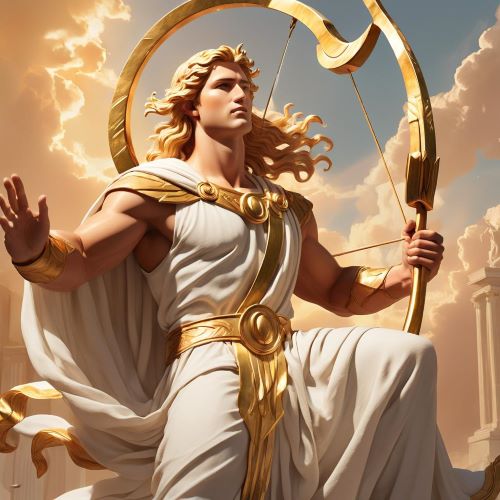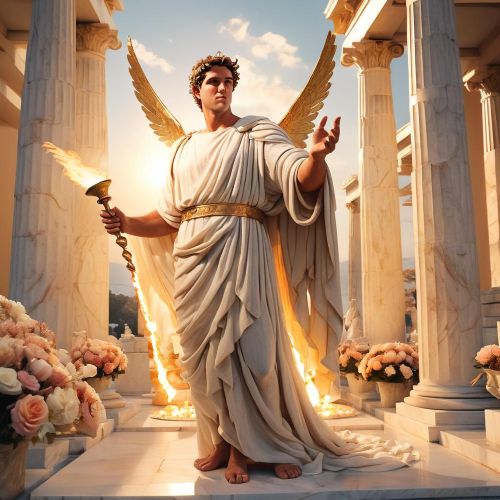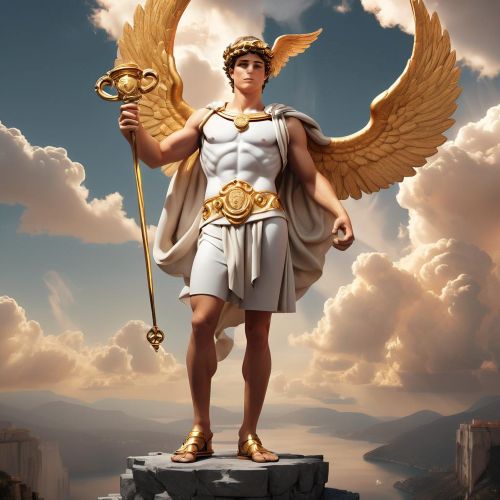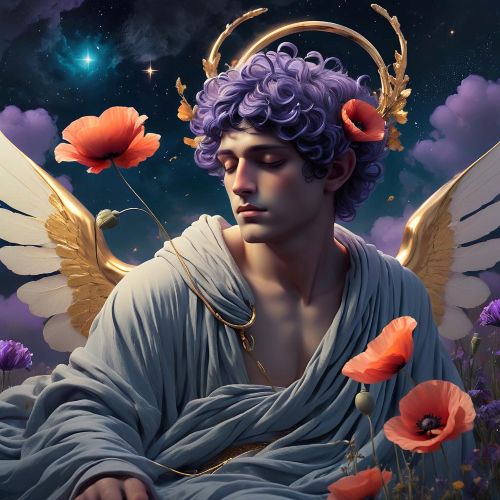Aether : God of Light
Listen
At a glance
| Description | |
|---|---|
| Origin | Mediterranean Mythology |
| Classification | Gods |
| Family Members | N/A |
| Region | Greece, Italy |
| Associated With | Light, Morning |
Aether
Introduction
In the mythology of both Greece and Rome, Aether (Greek: Αἰθήρ, Latin: Aether or Ether) represents the purest essence of the heavens. He is the personification of the bright upper air, the radiant atmosphere that the gods themselves breathe. Unlike the Olympian or Capitoline gods who influence human affairs, Aether belongs to the primordial generation of deities—forces that emerged at the dawn of creation to shape the very structure of the cosmos. In Greek tradition, Aether embodies divine illumination, while in Roman thought, he became associated with the clarity of the sky, cosmic order, and even a foundational element in philosophy and science. Both cultures viewed him not as a god of personality and myth but as the very substance of celestial life.
Physical Traits
Aether, unlike the anthropomorphic gods such as Zeus or Jupiter, is rarely described with human features. Instead, he is envisioned as a luminous and incorruptible substance that fills the upper reaches of the sky. To the Greeks, this divine atmosphere was the shining medium that carried light across the heavens, a substance untainted by earthly impurities. Roman writers inherited this conception, often describing Aether as the fiery brilliance of the heavens, a transparent ether that enveloped the gods and separated their domain from the mortal world. The name itself comes from the Greek verb aitho, meaning “to blaze” or “to burn,” underscoring his association with fire, brilliance, and radiance. In art and literature, Aether is often symbolized not by form but by golden light, shimmering skies, and the boundless expanse of the upper air.
Family
The genealogy of Aether varies between traditions, but in both Greek and Roman cosmology, he is always connected with the forces of light and creation. According to Hesiod’s Theogony, Aether was born from Nyx (Night) and Erebus (Darkness), making him the brother of Hemera (Day). Their union represents the eternal cycle of night giving way to day, shadow dissolving into brilliance. In the Orphic cosmogony, however, Aether arises from Chronos (Time) and Ananke (Necessity), alongside Chaos and Erebus, which highlights his role as an inevitable manifestation of time’s unfolding. Roman adaptations also absorbed him into their mythic frameworks, sometimes naming Aether and Dies (Day) as the parents of Caelus (Sky), who in turn fathered Saturn and Jupiter. This reflects the Roman tendency to align primordial forces with the genealogy of their major gods, weaving Aether into the larger structure of cosmic order.
Other names
Aether was not limited to a single definition. In some Greek traditions, he was called Acmon, meaning “the untiring” or “the zenith,” which emphasized his eternal presence above the mortal world. In Orphic texts, he was linked to Phanes, the radiant deity of creation, showing that Aether could also be viewed as a generative force. The Romans, too, integrated Aether into their philosophical and natural theories. Stoic philosophers considered him the divine fiery air that made up the stars, while Aristotelian thought defined him as the fifth element—the quintessence—that filled the heavens beyond the terrestrial sphere. Medieval scholars later adopted this Romanized concept of aether into alchemy and natural philosophy, ensuring the idea persisted long after worship of the old gods faded. These overlapping identities reveal how Aether served as both a mythological deity and a philosophical principle bridging science and religion.
Powers and Abilities
The powers of Aether lie not in weapons or actions but in his very existence as the embodiment of divine light and cosmic purity. In Greek tradition, he was the light that dispels darkness, making visibility and clarity possible in both the mortal and divine realms. The Orphic writings described him as the primal substance from which the stars and even the Isles of the Blessed were formed. To the Romans, Aether was the fiery atmosphere of the heavens, the breath of the gods that sustained immortality. Philosophers saw him as the medium that allowed celestial bodies to move in perfect harmony, a force that kept the cosmos in balance. In later interpretations, Aether became connected to the soul itself, imagined as a fiery or aetherial essence that connected humanity to the divine. Thus, whether Greek or Roman, his abilities were less about direct intervention and more about being the ever-present foundation of the universe.
Modern Day Influence
Though no longer venerated as a god, Aether has had a lasting impact on both science and culture.
In science and philosophy, the Roman interpretation of aether became central to pre-modern physics. For centuries, scholars believed in a “luminiferous ether” as the invisible medium through which light and celestial forces traveled. While Einstein’s theory of relativity ultimately replaced this model, modern concepts such as quantum fields and dark energy echo the same idea of a universal medium. In some speculative physics, a form of “neo-aether” is even proposed as a way to unify the laws of the cosmos.
In literature and art, Aether remains a symbol of celestial brilliance. Poets often use him as a metaphor for illumination, while visual artists draw inspiration from his golden radiance to depict divine or heavenly light. In Roman-influenced Renaissance thought, aether was often painted as the divine substance separating earth from heaven.
In popular culture, Aether has become a staple term in fantasy and science fiction. It often appears in video games, anime, and novels as a mystical energy source, a celestial plane, or the hidden force binding worlds together. In New Age spirituality, Aether is invoked as a symbol of universal consciousness or the spiritual light that connects all beings.
In branding and technology, the name “Aether” continues to resonate. Companies use it to suggest purity, elegance, or futuristic innovation, drawing upon both the Greek image of radiant light and the Roman idea of cosmic order.
Related Images
Source
GreekMythology.com. (n.d.). Aether – Greek Mythology. Retrieved from https://www.greekmythology.com/Other_Gods/Aether/aether.html
Wikipedia contributors. (2024). Aether (mythology). Wikipedia. Retrieved from https://en.wikipedia.org/wiki/Aether_(mythology)
World Mythos. (n.d.). Aether: Ancient Greek Deity of Light and the Upper Sky. Retrieved from https://www.thegreekgods.org/aether/
Of One Tree. (2024). Aether: Exploring the Mysteries of the Greek God. Retrieved from https://ofonetree.com/aether-exploring-the-mysteries-of-the-greek-god/
R. Hard & H. J. Rose. (2003). The Routledge Handbook of Greek Mythology. https://www.taylorfrancis.com/books/9781317228073
AETHER (Aither) – Greek Primordial God of Light & the Heavenly Ether. (n.d.). https://www.theoi.com/Protogenos/Aither.html
Rachel Lockett. (n.d.). Aether: Primordial God of the Bright Upper Sky – History Cooperative. https://historycooperative.org/aether-primordial-god-of-the-sky/
Frequently Asked Questions
What is lorem Ipsum?
I am text block. Click edit button to change this text. Lorem ipsum dolor sit amet, consectetur adipiscing elit. Ut elit tellus, luctus nec ullamcorper mattis, pulvinar dapibus leo.
What is lorem Ipsum?
I am text block. Click edit button to change this text. Lorem ipsum dolor sit amet, consectetur adipiscing elit. Ut elit tellus, luctus nec ullamcorper mattis, pulvinar dapibus leo.
What is lorem Ipsum?
I am text block. Click edit button to change this text. Lorem ipsum dolor sit amet, consectetur adipiscing elit. Ut elit tellus, luctus nec ullamcorper mattis, pulvinar dapibus leo.
What is lorem Ipsum?
I am text block. Click edit button to change this text. Lorem ipsum dolor sit amet, consectetur adipiscing elit. Ut elit tellus, luctus nec ullamcorper mattis, pulvinar dapibus leo.
What is lorem Ipsum?
I am text block. Click edit button to change this text. Lorem ipsum dolor sit amet, consectetur adipiscing elit. Ut elit tellus, luctus nec ullamcorper mattis, pulvinar dapibus leo.


